Printable Version of Topic
Click here to view this topic in its original format
GMC Forum _ THEORY _ Eighth Note Triplets
Posted by: Phil66 Oct 6 2020, 08:50 PM
Hello folks,
As part of my injury rehab I'm learning https://www.guitarmasterclass.net/ls/SlowBluesinAMinor/ lesson as it's not too demanding on my left arm/shoulder, as a side lesson Gab suggested https://www.guitarmasterclass.net/ls/Triplets-Exercise/ lesson.
One thing that is confusing me, and please don't say "Just play your guitar" ![]() I have a need to understand. My question is this, Why are eighth note triplets called "eighth notes" when there are twelve of them???? Shouldn't they be called twelfth note triplets? I thought eighth notes lasted for an eighth of a bar???
I have a need to understand. My question is this, Why are eighth note triplets called "eighth notes" when there are twelve of them???? Shouldn't they be called twelfth note triplets? I thought eighth notes lasted for an eighth of a bar??? ![]()
![]()
I think this is the kind of thing that makes music theory difficult for me to take in.
I've asked Gab in my thread but I've posted it here to help others too.
Cheers
Phil
Posted by: Caelumamittendum Oct 6 2020, 08:53 PM
As part of my injury rehab I'm learning https://www.guitarmasterclass.net/ls/SlowBluesinAMinor/ lesson as it's not too demanding on my left arm/shoulder, as a side lesson Gab suggested https://www.guitarmasterclass.net/ls/Triplets-Exercise/ lesson.
One thing that is confusing me, and please don't say "Just play your guitar"
I've asked Gab in my thread but I've posted it here to help others too.
Cheers
Phil
They are not really called "eighth notes" though, they're called "eighth note triplets".
And if they were 12-note triplets you would have 18 twelve-notes! But twelve-notes are not a thing anyway. How would you flag a 12th-note in notation? Mathematically of course it could probably be considered a thing.
It's in the name "triplet", really, for me at least. Or rather that it means playing 3 notes in the time of two. Whether that is three 16th-notes in the time of two 16-the notes (16th-note triplets) or 8th note triplets. Or quarter-note triplets for that matter. Any note value can be a triplet, though some are not used that much.
Posted by: Potsau Oct 6 2020, 11:44 PM
Use a metronome. every click you must clap 3 times. The 4th clap should end on the 2nd click. and so on. All in all, try to clap 3 times within one click. So you got 12 8ths in a 4/4.
Posted by: Phil66 Oct 7 2020, 06:06 AM
Thanks, yes I get that, it's 123 223 323 423, it's having 12 eighth notes that gets me, it's like saying I have twelve eighths of a pint of beer in this point glass.
Cheers
Posted by: Caelumamittendum Oct 7 2020, 06:12 AM
Cheers
Did you see my attempt at explaining it?
Posted by: Phil66 Oct 7 2020, 06:15 AM
Thanks Ben,
I don't really get the "playing two notes in the time of two", in this instance three notes are played per quarter note . In my head it would make more sense to call them quarter note triplets as each triplet is played on a quarter note. At least then there is some relationship going on. With the term "eighth note triplet", I can't see anything to do with eight anywhere.
Cheers buddy
Phil
I was typing my reply as you were typing that
See above.
Posted by: Caelumamittendum Oct 7 2020, 06:27 AM
I don't really get the "playing two notes in the time of two", in this instance three notes are played per quarter note . In my head it would make more sense to call them quarter note triplets as each triplet is played on a quarter note. At least then there is some relationship going on. With the term "eighth note triplet", I can't see anything to do with eight anywhere.
Cheers buddy
Phil
It's three notes in the time of two though. Not two in two. Two in two would not be a triplet. A quarter note triplet would be three quarter notes in the time of two quarter notes though, so using that term gets some other note values mixed.

Essentially a triplet is 3 notes of a specific note value played over the same duration of 2 notes of the same specific note value.
EDIT: You could also look at it this way: A triplet is 2/3 of that given note value notated by the flag of the rhythm value. I think the answer to your original question of why it can't be twelve-notes is because of the way we notate rhythm with the flags. 8th notes having one line, 16th notes two and so on. Our rhythm notation is in it's simplest form powers of two - 1 (whole), 2 (half), 4 (quarters), 8 (eighth), 16, 32 and so on. To notate a note lasting a "twelvth note" you'd have to notate it in a way that would make sense, and I personally think a triplet rhythm notation makes sense for that.
See above.
No worries, thought you'd missed it
Posted by: Caelumamittendum Oct 7 2020, 07:01 AM
Here's another decent video:
Cheers
With a triplet it would be more like saying you have twelve "2/3rds of eights" of a pint, adding up to a full pint.
Posted by: Phil66 Oct 7 2020, 07:23 AM

Essentially a triplet is 3 notes of a specific note value played over the same duration of 2 notes of the same specific note value.
EDIT: You could also look at it this way: A triplet is 2/3 of that given note value notated by the flag of the rhythm value. I think the answer to your original question of why it can't be twelve-notes is because of the way we notate rhythm with the flags. 8th notes having one line, 16th notes two and so on. Our rhythm notation is in it's simplest form powers of two - 1 (whole), 2 (half), 4 (quarters), 8 (eighth), 16, 32 and so on. To notate a note lasting a "twelvth note" you'd have to notate it in a way that would make sense, and I personally think a triplet rhythm notation makes sense for that.
No worries, thought you'd missed it
Thanks Ben,
It kinda makes sense now sort of in a way
I haven't had chance to watch the video, I'll try this evening. I understand why people say "Just play it", when it comes to understanding what you're doing, and often doing intuitively, it can get in the way. I've played things in the past and played them okay, then I've come across something, like maybe eighth note triplets, and when you think about it and try to do it, you struggle. Weird.
Cheers buddy, thank you for your time.
Phil
Posted by: Gabriel Leopardi Oct 7 2020, 02:49 PM

Excellent explanation Cael! This graphic explains it very clearly.
Posted by: Phil66 Dec 20 2020, 03:45 PM
Would quarter note triplets played at 180bpm sound like eighth note triplets played at 90bpm?
Posted by: Caelumamittendum Dec 20 2020, 04:58 PM
Yes
Posted by: Phil66 Dec 20 2020, 05:31 PM
I thought so but every time I think something about music theory I get thrown a curve ball ![]()
Posted by: Todd Simpson Dec 21 2020, 03:00 AM
Great job on the explanation BEN!!! I've never thought of it this way but it's perfect. Well done.
Posted by: Caelumamittendum Dec 22 2020, 07:15 AM
The picture wasn't mine, but it's the way I "see" triplets. I was going to make a similar picture in Guitar Pro, but someone had already done so on Google and it was easier to just use that
Posted by: Phil66 Dec 22 2020, 08:24 AM
Sooooo, if you play triplets on the 1, 2, 3 and 4 it's the same as your diagram? except your diagram has the & note inbetween making it eighth note triplets but they are just the same as quarter note triplets?
Would you play 16th note triplets just on the 1, 2, 3, and 4? So each triplet would be played over four 16th notes?
I'm just trying to get this in my head, music often seems unnecessarily complex.
Cheers
Phil
Posted by: Caelumamittendum Dec 22 2020, 08:39 AM
Would you play 16th note triplets just on the 1, 2, 3, and 4? So each triplet would be played over four 16th notes?
I'm just trying to get this in my head, music often seems unnecessarily complex.
Cheers
Phil
The diagram from above shows 8th note triplets. They are not the same as quarter note triplets.
"Triplets" is a bit of a vague term, I'd say. As you really need the notation rhythm value too, i.e. "eight note triplets" (there would be 12 of those in a bar of 4/4). Quarter note triplets you would have 6 in a bar of 4/4. Half note triplets you would have 3. And to go in the other direction you would have twenty-four 16th note triplets, so yes, they would land one beat 1, 2, 3 and 4 - with 6 notes in each beat.
A quarter note triplet would look like this (the top section):
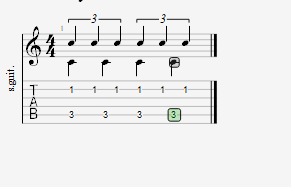
I've notated the regular quarter notes so you can see them, as well as the pulse in the bar.
I think what's confusing you is that a triplet is NOT three notes in the time of the note-value. I.e. a quarter note triplet is not three notes in the space of 1 quarter note, but rather 3 notes in the time of 2 quarter notes. Same with the eighth note triplets
I would think of "eighth note triplets" as quicker eighth notes, if that makes sense.
Maybe I'm causing more confusion here, but:
1 quarter note = 2 eighth notes = 3 eighth note triplets
Posted by: Phil66 Dec 22 2020, 11:28 AM
Thanks for your patience and explanation Ben, I appreciate it but, I think for now I need to shut up and play my guitar ![]()
Posted by: Phil66 Oct 11 2021, 08:37 PM
I think I might have hit on something, maybe, just maybe, someone will probably come along and say "Oi, Phil, NOOOOOOOOOO" (You'll get it if you watch the video ![]()
Anyway, I think a lot of my confusion is bourne out of the terminology. A quarter note lasts a quarter as long as a whole note, yes? But only in 4/4 time, in 3/4 time. doesn't it last a third as long as a whole note?
If I'm right, then this is the tip of the iceberg of my misunderstanding of the whole note length thing. I think I prefer the word "crochet".
I might be blowing outta my behind though.
https://youtu.be/Ks7AwE3Xpfk
Posted by: Caelumamittendum Oct 11 2021, 09:58 PM
A quarter note is the same length no matter the time signature. Doesn't matter if it's in a quarter note in 7/8, 21/32, 4/4 or 3/4 time signature ![]()
A whole note in 3/4 will actually last longer than the bar, and thus not be "possible" to notate in 3/4. A whole note is 4 quarter notes, adding up to one bar of 3/4 plus a quarter note - making it last 4/4. So a quarter note in 3/4 will still be that 1/4. How many quarters does it take to fill 3/4? It takes 3, but they're still the same size quarters as the 4 quarters in 4/4.
A whole note is...a whole note. 1/1 or 4/4, 8/8 etc. A whole note in 3/4 will not be 3/4, as that's not "whole", but the length of three quarter notes. 7/8 is the length of 7 eighth notes...or 3½ quarter notes.
The note value length themselves do not change depending on the time signature. A quarter note in 4/4 will last just as long as in 3/4, 7/8 or 21/16.
The only thing that makes an individual note value change the length it is being played is the BPM a song is played at. I.e. A quarter note at 120 bpm is faster than one in 90 BPM. It doesn't get faster or slower by being in 3/4 or 4/4.
Have you ever thought of it as math?
Whole note = 1/1
Half note = 1/2
Quarter = 1/4
Eighth = 1/8
Sixteenth = 1/16
How many quarter notes does it take to fill 3/4? It takes three.
How many quarter notes does it take to fill 4/4? It takes four. Which is equal to 1/1 or the length of a whole note.
The length of the quarter doesn't change.
How many whole notes are there in a bar of 3/4 though? Since a whole note is 1/1, the answer will be that they "overflow" the bar, hence leading to going into the next bar of 3/4, but not filling that bar up. Essentially a whole note is 4/4, but since our bar is filled at 3/4 the last part of the whole note's length woulc have to carry on into the next bar.
EDIT: Adding GP files. 4_four_and_3_4.gp5 ( 3.06K )
: 275
4_four_and_3_4.gp5 ( 3.06K )
: 275 4_four_and_3_4.gp ( 9.64K )
: 288
4_four_and_3_4.gp ( 9.64K )
: 288
And with different instruments and pan to easier hear it. Notice the text above the staff. 4_four_and_3_4__different_instruments_and_pan_.gp ( 9.85K )
: 287
4_four_and_3_4__different_instruments_and_pan_.gp ( 9.85K )
: 287
To sum up: A quarter note is 1/4, a whole note is 1/1. A 4/4 is four quarter notes, and 3/4 is three quarter notes, but the length (time it plays) of a quarter note is not different in 4/4 or 3/4 or any other time signature. A quarter note will never last a third of a whole note.
Screenshot for those who do not have Guitar Pro: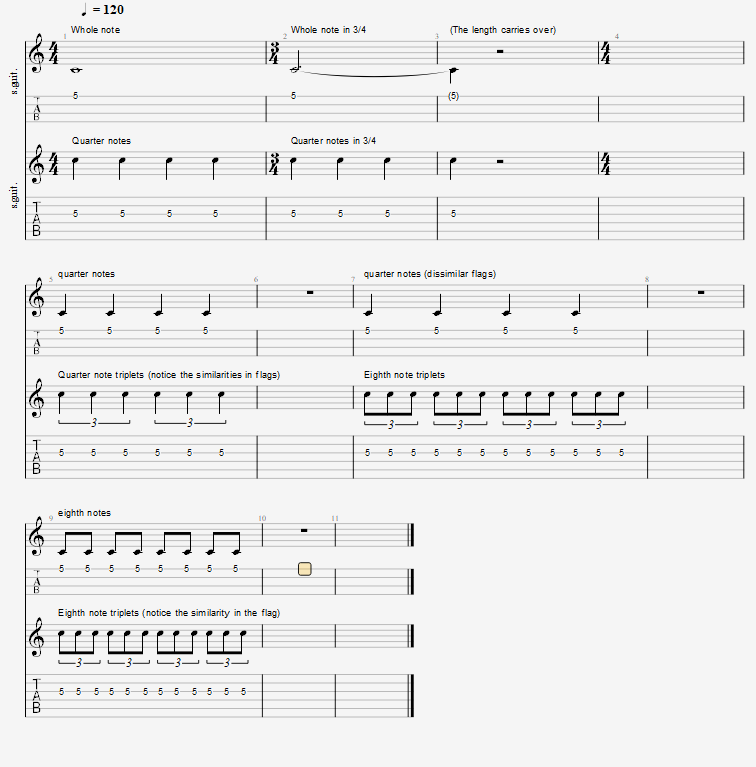
Posted by: Phil66 Oct 12 2021, 07:26 AM
Oi Phil, NOOOOOO ![]()
Thanks Ben, I appreciate your help, I just don't think it's ever going to sink in. I'm good at maths but when applied to music I have a mental block. I think I might take up pottery ![]() I was thinking that maybe "quarter note" didn't actually refer to an actual quarter but had, over the years, just become nomenclature. Wishful thinking I suppose
I was thinking that maybe "quarter note" didn't actually refer to an actual quarter but had, over the years, just become nomenclature. Wishful thinking I suppose ![]()
I'll read through your explanation a few times. Cheers
UPDATE: Basically, note length has nothing to do with bar length, it is to do with BPM, I think.
Posted by: Caelumamittendum Oct 12 2021, 11:58 AM
Try to think of rhythm theory as math, really.
A whole = 1/1, half = 1/2, quarter 1/4... and so on. I'm sure you know these.
1/1 = 2/2 = 4/4 = 8/8 = 16/16 and so on.
1/4 = 2/8 = 4/16.
Here are some nice illustrations take from https://musictheorysite.wordpress.com/2015/06/16/rhythmic-values-and-simple-metre/: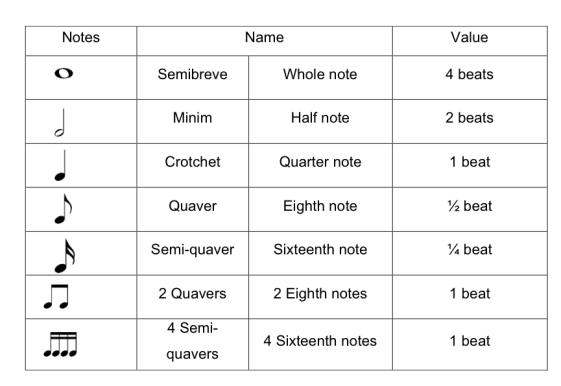
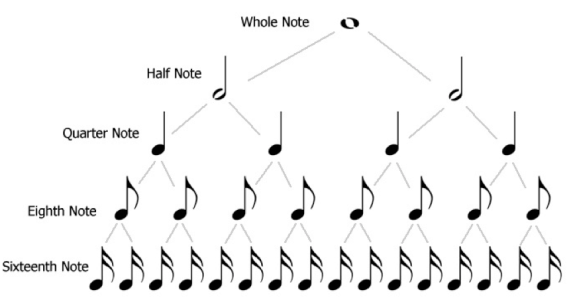
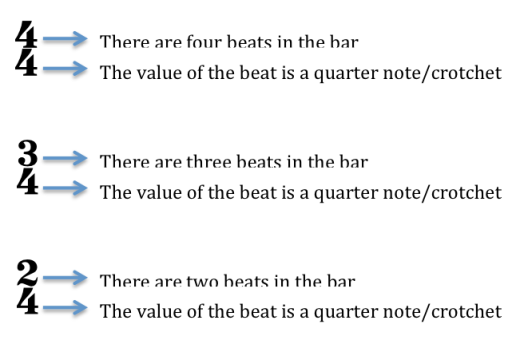
However a bar of 3/4 is "complete" at a value of three quarter notes. Remember how typically we count 1, 2, 3, 4 in 4/4? Those beats are quarter notes. In 3/4 we count 1, 2, 3 and then start over. And those are also quarter notes, but there are only 3 of them to complete the bar.
An exercise could be to think about how many note values it takes to fill 7/8, 5/4 or any other time signature you might use, but be free to use any note value. Pink Floyd has some songs that use some other time signatures ("Money" for instance).
I'll give you an example:
7/8 has seven 8th notes to be complete, but as we saw earlier in this post two 8th notes equal a quarter note. This means we could also have three quarter notes plus an 8th note to fill the bar. This time signature is more advanced than 3/4 or 5/4 of course, but the principle is the same.
Thinking of these note values as divisions (they are literally divisions) can also help in understanding rhythm.
A bar of 4/4 could be made up of these combined values for instance (this is just an example, there are endless combinations):
Five 16th-notes, one 8th-note, one 16th note and 2 quarter-notes. This will add up to 4/4, which is essentially the same length as one whole-note.
You could try to do a similar execise for 3/4 using any combination of note-values, as long as they add up to a total of 3/4. The exercise can be done for any time signature.
You will probably notice that a whole-note (Remember it means "whole" as in 1/1 = 2/2 = 4/4) cannot be fitted into the bar, and the only way to play it would be to tie it over the bar-line, meaning we would write that whole-note note-value as "something that fits into 3/4" (you do the math ![]() ) and whatever is left of it is tied on in the next bar (hint: there's an example in GP file from my last post).
) and whatever is left of it is tied on in the next bar (hint: there's an example in GP file from my last post).
Remember that a "quarter note" will NOT have different lengths in 3/4, 4/4, 5/4 or 15/16 for that matter. Only thing that changes the note length of a quarter note is the BPM of the song or exercise. Time signature is not equal to the tempo (BPM), but to how the song is counted.
I'm gonna stop here before going into explaining more behind BPM as it can complicate things, but I'm more than open to continue about that ![]()
-------------
Let's also sum up quickly about triplets from earlier:
A triplet is 3 notes in the time of 2. 8th-note triplets have a "3" marked above them (sometimes not in classical music notation), but the flags on the notes are the same as that of a regular 8th note - a single flag. Similarly 16th notes have 2 flags. 16th note triplets have 2 flags, but also a 3 above them.
---------------
BONUS info on the blues shuffle:
In blues you often have a shuffle feel, which is actually indicated as this: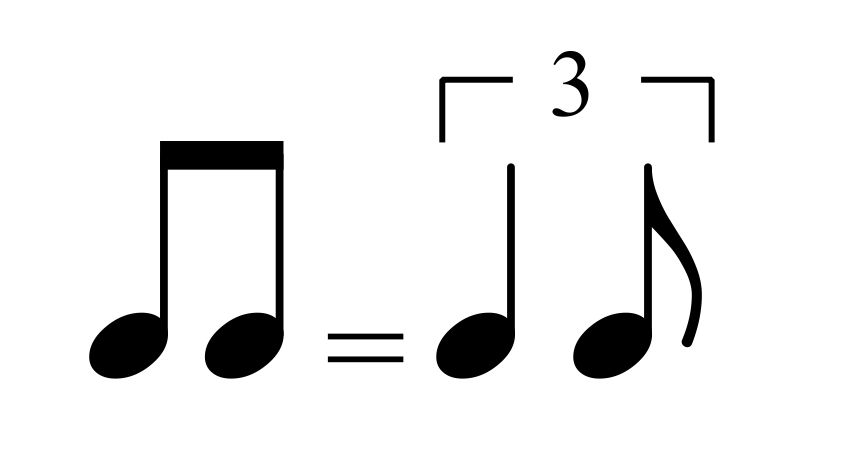
The simple explanation is that it means that two 8th notes are played as "1 quarter note triplet + 1 eigth note triplet" - you know that shuffly feel of holding the first note longer and the second one shorter. It comes from feeling it like triplets actually, and here is an illustration: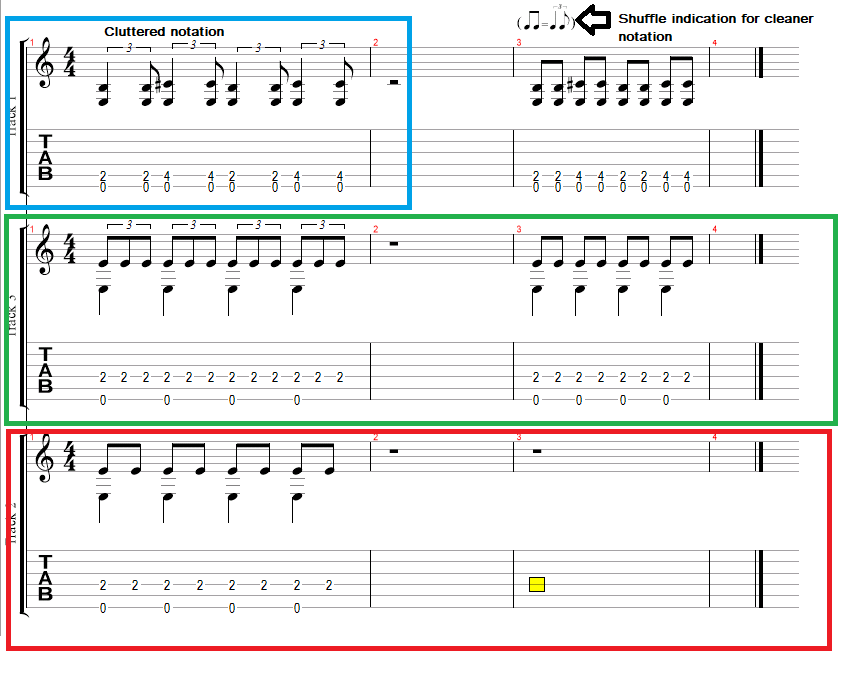
Notice how the blue square is a bit cluttered notation wise, and the shuffle marking clears up the notation a bit. However, they are still played the same way. The note values in green and red are there to illustrate subdivions. You can see how the quarter-note beat still falls on 1, 2, 3, 4, while there are eight 8th-notes to fill the bar. Meanwhile you can also see the triplets and how a quarter-note triplet equals two 8th-note triplets (you will have to compare the rhythm in the blue square with the upper rhythm of the green square). Guitar Pro does a good job of lining these up for a visual representation too.
Posted by: Phil66 Oct 12 2021, 12:20 PM
Thanks Ben,
Yeah I get the maths but as said, for some crazy reason I thought it had become nomenclature.
In my update above I said "UPDATE: Basically, note length has nothing to do with bar length, it is to do with BPM, I think."
So at 60bpm, a quarter note would last one second, a whole note would last 4 seconds etc etc.
Cheers
Posted by: Caelumamittendum Oct 12 2021, 12:30 PM
Yeah I get the maths but as said, for some crazy reason I thought it had become nomenclature.
In my update above I said "UPDATE: Basically, note length has nothing to do with bar length, it is to do with BPM, I think."
So at 60bpm, a quarter note would last one second, a whole note would last 4 seconds etc etc.
Cheers
Yes, I noticed your edit as I was 3/4 through writing my reply. I decided to just finish the reply. Maybe there is some useful information for someone else
Posted by: MonkeyDAthos Oct 12 2021, 02:22 PM
A whole note in 3/4 will actually last longer than the bar, and thus not be "possible" to notate in 3/4. A whole note is 4 quarter notes, adding up to one bar of 3/4 plus a quarter note - making it last 4/4. So a quarter note in 3/4 will still be that 1/4. How many quarters does it take to fill 3/4? It takes 3, but they're still the same size quarters as the 4 quarters in 4/4.
A whole note is...a whole note. 1/1 or 4/4, 8/8 etc. A whole note in 3/4 will not be 3/4, as that's not "whole", but the length of three quarter notes. 7/8 is the length of 7 eighth notes...or 3½ quarter notes.
The note value length themselves do not change depending on the time signature. A quarter note in 4/4 will last just as long as in 3/4, 7/8 or 21/16.
The only thing that makes an individual note value change the length it is being played is the BPM a song is played at. I.e. A quarter note at 120 bpm is faster than one in 90 BPM. It doesn't get faster or slower by being in 3/4 or 4/4.
Have you ever thought of it as math?
Whole note = 1/1
Half note = 1/2
Quarter = 1/4
Eighth = 1/8
Sixteenth = 1/16
How many quarter notes does it take to fill 3/4? It takes three.
How many quarter notes does it take to fill 4/4? It takes four. Which is equal to 1/1 or the length of a whole note.
The length of the quarter doesn't change.
How many whole notes are there in a bar of 3/4 though? Since a whole note is 1/1, the answer will be that they "overflow" the bar, hence leading to going into the next bar of 3/4, but not filling that bar up. Essentially a whole note is 4/4, but since our bar is filled at 3/4 the last part of the whole note's length woulc have to carry on into the next bar.
EDIT: Adding GP files.
 4_four_and_3_4.gp5 ( 3.06K )
: 275
4_four_and_3_4.gp5 ( 3.06K )
: 275 4_four_and_3_4.gp ( 9.64K )
: 288
4_four_and_3_4.gp ( 9.64K )
: 288And with different instruments and pan to easier hear it. Notice the text above the staff.
 4_four_and_3_4__different_instruments_and_pan_.gp ( 9.85K )
: 287
4_four_and_3_4__different_instruments_and_pan_.gp ( 9.85K )
: 287To sum up: A quarter note is 1/4, a whole note is 1/1. A 4/4 is four quarter notes, and 3/4 is three quarter notes, but the length (time it plays) of a quarter note is not different in 4/4 or 3/4 or any other time signature. A quarter note will never last a third of a whole note.
Screenshot for those who do not have Guitar Pro:

Posted by: Caelumamittendum Oct 12 2021, 04:13 PM
Yes, quite often. I did sort plan out some subjects for a book some years back, but I didn't get too far with it. I don't like teaching live real life lessons though, so I think I would prefer making pre-planned videos and PDF files - and at a push some streams.
However there are a few other barriers of course, but maybe some day I'll manage to break through them. It is something I'm thinking about and considering.
Posted by: Todd Simpson Oct 13 2021, 02:25 AM
Wow. That's the best explanation of time I think I've ever seen. I hope it gets put in our wiki! I'm gonna PM Fran.
Todd
A whole = 1/1, half = 1/2, quarter 1/4... and so on. I'm sure you know these.
1/1 = 2/2 = 4/4 = 8/8 = 16/16 and so on.
1/4 = 2/8 = 4/16.
Here are some nice illustrations take from https://musictheorysite.wordpress.com/2015/06/16/rhythmic-values-and-simple-metre/:

 plets (you will have to compare the rhythm in the blue square with the upper rhythm of the green square). Guitar Pro does a good job of lining these up for a visual representation too.
plets (you will have to compare the rhythm in the blue square with the upper rhythm of the green square). Guitar Pro does a good job of lining these up for a visual representation too.Posted by: Caelumamittendum Oct 14 2021, 07:06 PM
Todd
Thanks, Todd. It was very much off the top of my head written-in-a-hurry kinda thing. I'd go more in depth with stuff like this if I were to write lesson material on it.
Powered by Invision Power Board (http://www.invisionboard.com)
© Invision Power Services (http://www.invisionpower.com)
